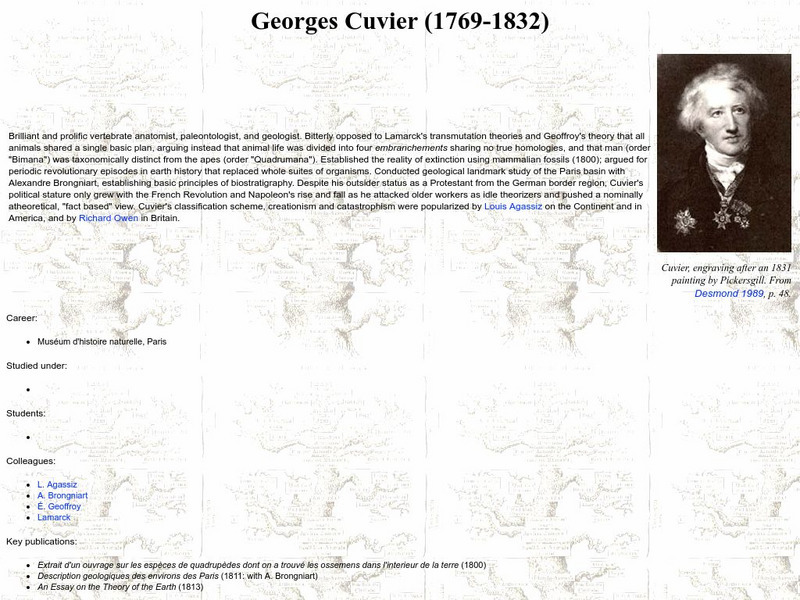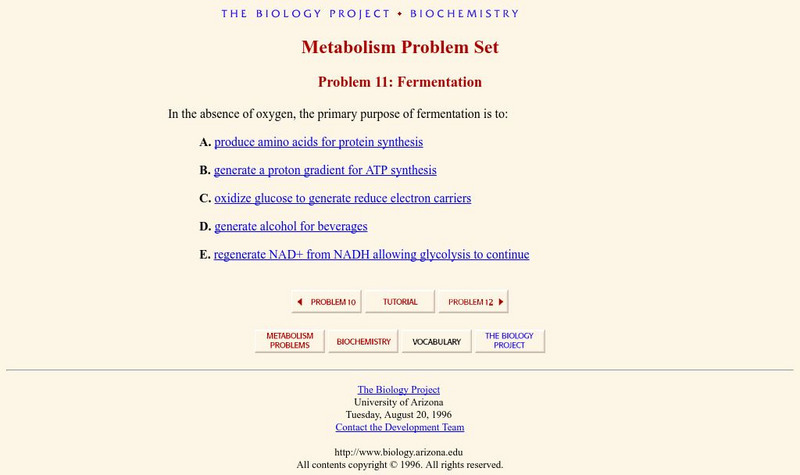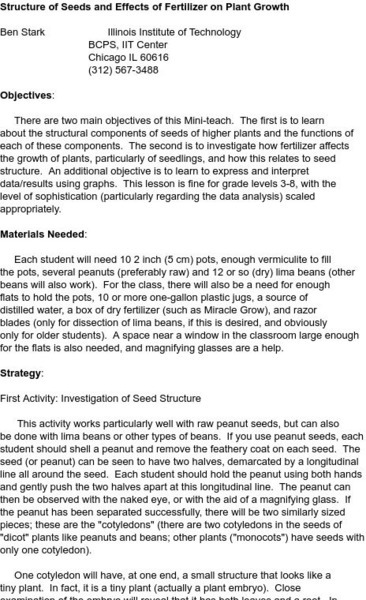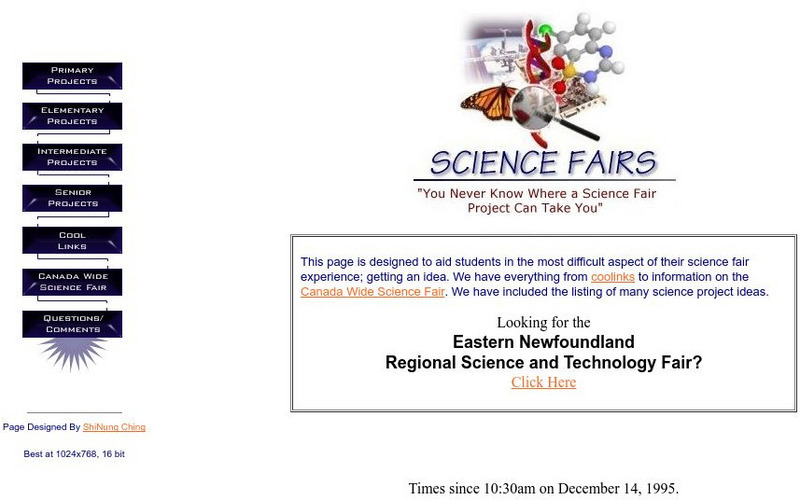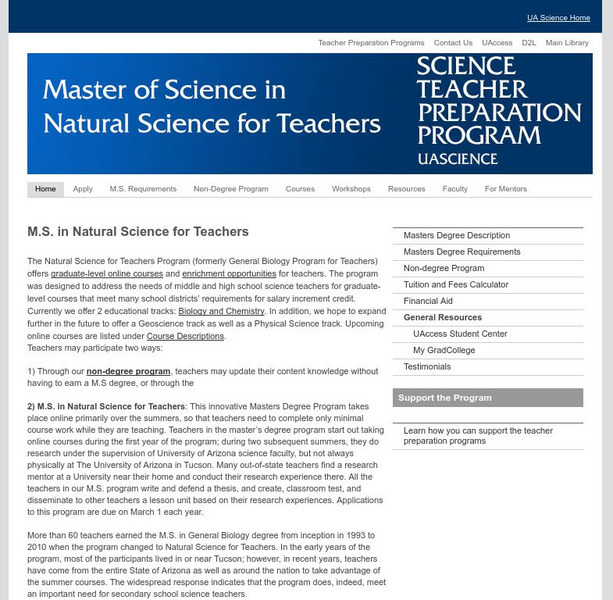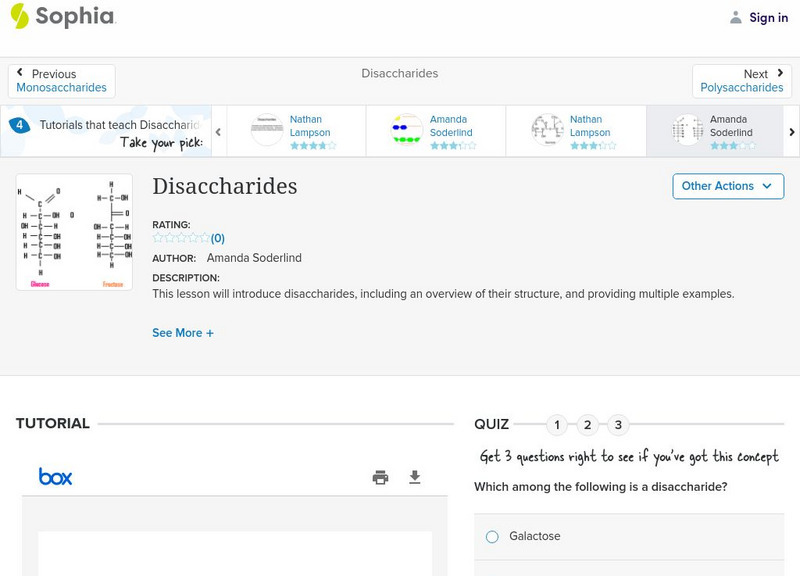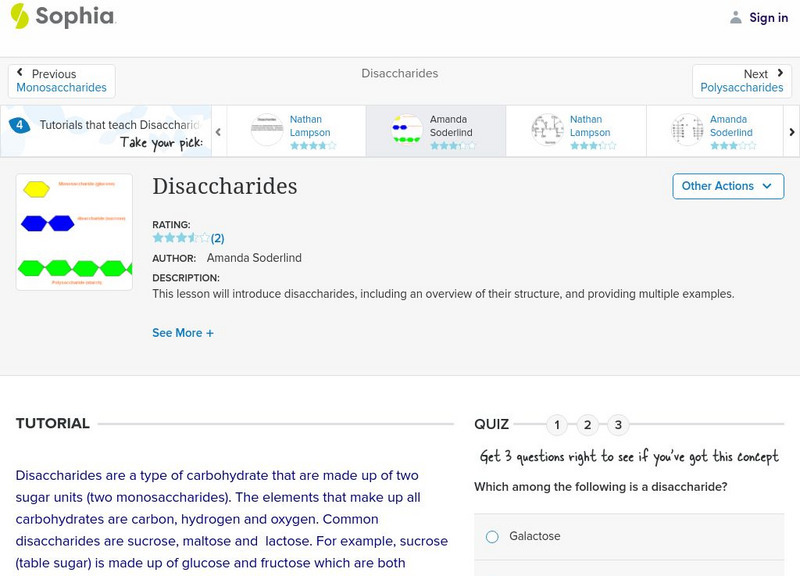Cosmo Learning
Cosmo Learning: Introductory Biology
A collection of video lectures from an introduction to biology course taught at Massachusetts Institute of Technology. The course covers fundamental topics like biochemistry, genetics, molecular biology, and cell biology with thirty-four...
National Center for Ecological Analysis and Synthesis, University of California Santa Barbara
University of California: George Cuvier
This site from the University of California discusses the contributions and ideas of George Cuvier related to classification, evolution, and catastrophism.
University of Arizona
University of Arizona: Metabolism Problem Set: Problem 11 Fermentation
Answer the question wrong and you will get a brief tutorial in the right direction. Answer it right and you must know what you are talking about. Part of a larger quiz on cellular respiration.
University of California
University of California: Geometry in Action
This page collects various areas in which ideas from discrete and computational geometry (meaning mainly low-dimensional Euclidean geometry) meet some real-world applications.
University of California
Princeton University: Mary Styles Harris
This site, from the Princeton University, gives a profile of biologist Mary Styles Harris which includes her work, her writing, and her research.
Science and Mathematics Initiative for Learning Enhancement (SMILE)
Smile: Investigating the Structure of the Flower
This lesson plan has students make a model of a flower's structure using clay, toothpicks, and construction paper.
Science and Mathematics Initiative for Learning Enhancement (SMILE)
Smile: Structure of Seeds and Effects of Fertilizer on Plants
In this lesson plan, students identify parts of seeds and the effect of fertilizer on their germination and development.
Wikimedia
Wikipedia: Timeline of Biology and Organic Chemistry
A timeline of important events in biology and organic chemistry. Links to related topics.
abcteach
Abcteach: Ponds
[Free Registration/Login Required] The abcteach directory contains sample pages from their pond unit for non-members. Handouts are in PDF format.
Open Curriculum
Open Curriculum: Flow of Energy in Ecosystems
Students will understand and describe food chains and food webs, and explain how energy is transferred between their trophic levels.
Other
Life in Caves
This site contains several photographs of cave dwelling animals. Most of the webpage is devoted to bats, but there is also information on other species such as cave crickets, crabs, millipedes, and salamanders.
Other
Perth Museums
This site describes 14 of Australia's museums. No links are provided, only information and addresses.
Other
Mammals and Their Babies
Twelve mammal baby pictures are displayed in this resource. If you roll your mouse over a picture you can see the adult version of the same animal.
Other
The frog.org: Biology, Movement
TheFrog.org provides a site dedicated to information and links on frogs. This particular page discusses how the amphibian moves.
Other
Cdli: Science Fairs Homepage
At this site from the Center for Distance Learning and Innovation there's a monstrous listing of possible science fair projects. You can choose from primary (grades 1-4), elementary (grades 4-6), intermediate (grades 7-9), or senior...
Other
Bryan Ness' Home Page: Tem Showing a Nucleolus
View an electron micrograph of a mast cell with obvious nucleolus. This picture has a caption.
University of Arizona
Univ. Of Az: Spiders: An Organism for Teaching Biology
Students capture spiders and then conduct various experiments to identify their spider, analyze its feeding rate, and discover its effect on populations of insects. Includes directions for student activities and teaching tips.
Sophia Learning
Sophia: Diffusion: Lesson 2
This lesson explains the process of diffusion. It explains how diffusion is a passive form of transport, used to move molecules down their concentration gradient. It is 2 of 8 in the series titled "Diffusion."
Sophia Learning
Sophia: Diffusion: Lesson 4
This lesson explains the process of diffusion. It explains how diffusion is a passive form of transport, used to move molecules down their concentration gradient. It is 4 of 8 in the series titled "Diffusion."
Sophia Learning
Sophia: Dihybrid Cross: Lesson 2
This lesson will explain how to use a Dihybrid cross when determining multiple genetic traits at once. It is 2 of 4 in the series titled "Dihybrid Cross."
Sophia Learning
Sophia: Dihybrid Cross: Lesson 3
This lesson will explain how to use a Dihybrid cross when determining multiple genetic traits at once. It is 3 of 4 in the series titled "Dihybrid Cross."
Sophia Learning
Sophia: Dihybrid Cross: Lesson 4
This lesson will explain how to use a Dihybrid cross when determining multiple genetic traits at once. It is 4 of 4 in the series titled "Dihybrid Cross."
Sophia Learning
Sophia: Disaccharides: Lesson 3
This lesson will introduce disaccharides, including an overview of their structure, and providing multiple examples. It is 3 of 4 in the series titled "Disaccharides."
Sophia Learning
Sophia: Disaccharides: Lesson 1
This lesson will introduce disaccharides, including an overview of their structure, and providing multiple examples. It is 1 of 4 in the series titled "Disaccharides."

